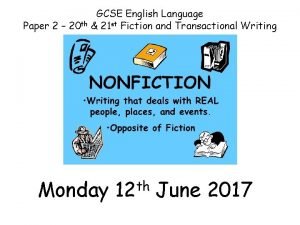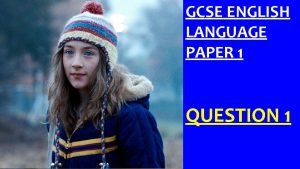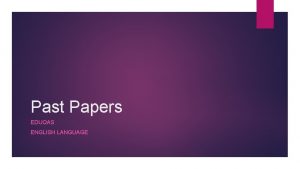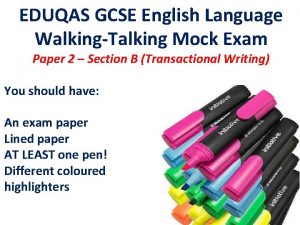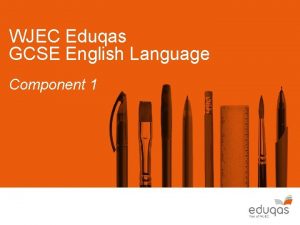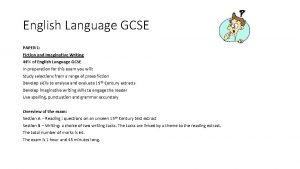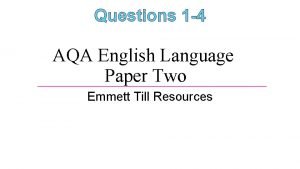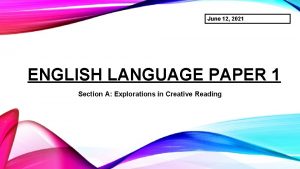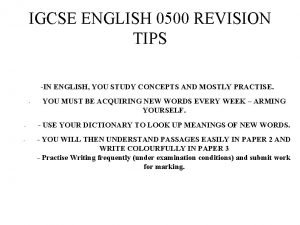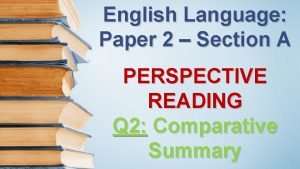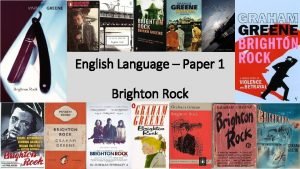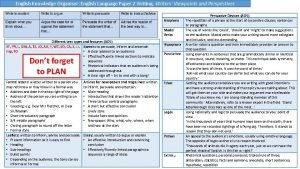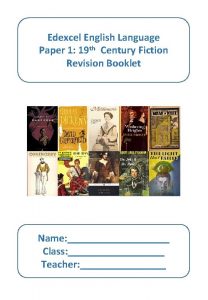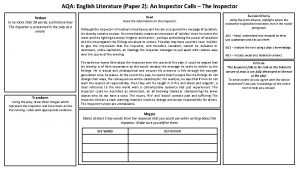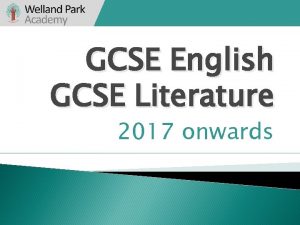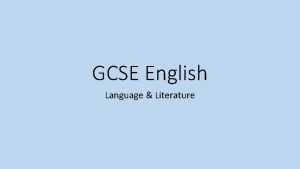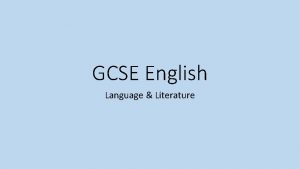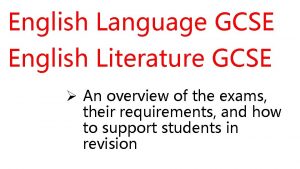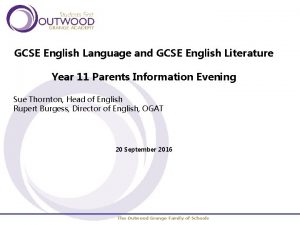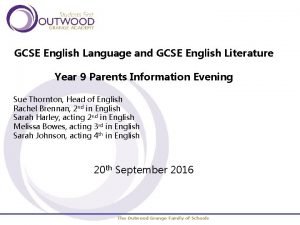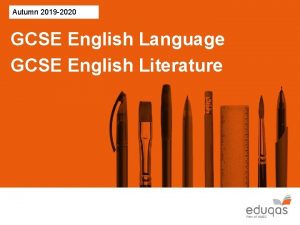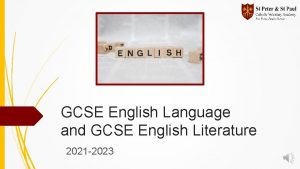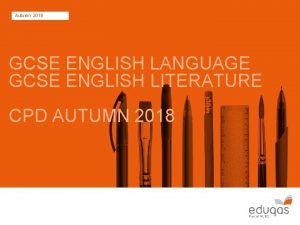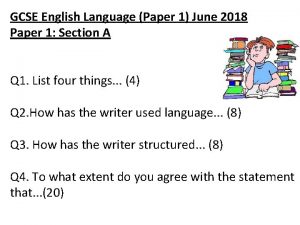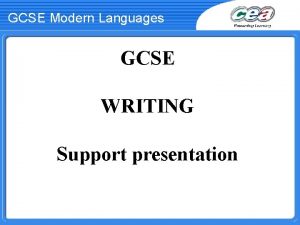GCSE English Language Paper 1 Overview of Language


















- Slides: 18

GCSE English Language Paper 1


Overview of Language Paper 1 Section A: Reading 40 marks 60 minutes Q 1: EXTRACT Q Total Time: 1: 45 Total marks: 90 LIST FOUR THINGS 4 marks and 5 minutes (+25% = 6 mins) Q 2: EXTRACT Q HOW DOES THE WRITER USE LANGUAGE TO… 8 marks + 10 minutes (+25% = 12 mins) EXTRACT Q Q 3: WHOLE TEXT Q HOW HAS THE WRITER STRUCTURED THE TEXT TO INTEREST YOU AS A READER 8 marks and 10 minutes (+25% = 12 mins) WHOLE TEXT Q Q 4: Extract Q (STATEMENT) TO WHAT EXTENT DO YOU AGREE? 20 marks and twenty-five minutes (+25% = 30 mins) Section B: Writing 40 marks 45 minutes Q 5: CREATIVE WRITING 40 marks and forty-five minutes (+25% = 55 mins)

Annotation = thinking and planning Successful students make notes on the texts and text extracts to help their thinking and to answer the questions correctly. Highlight key words in the Q and text As you read – scribble down your thoughts

English Language Paper 1 Key overview of P 1: one text (20 th or 21 st C) literary fiction. It will include extracts from novels and short stories and focus on openings, endings, narrative perspectives and points of view, narrative or descriptive passages, character, atmospheric descriptions and other appropriate narrative and descriptive approaches. You will be able to use the structure, ideas and language in your own writing for Section B.

Paper 1: The FIRST TEN MINUTES From opening the exam paper, you have ten (+25% = 12 mins) minutes to read, colour the questions and mark the extract. YOU should read the questions and then assign a colour to each question, highlight each question with its colour and then mark off the relevant sections of the extract for each question. Read the context information about the text – IN THE BOX AT THE TOP Read the text or boxed lines a couple of times, to ensure YOU understand it on a deep enough level. Good readers ask questions as they read. Think as you read!

Q 1: EXTRACT Q LIST FOUR THINGS 4 marks and 5 minutes (+25% = 6 mins) 1. Read the question and the lines specified 2. Highlight or underline the 4 quotations to use 3. Write one point per line with the question stem i. e. Mr Fisher ‘lives alone’ or He does not ‘own a car’ etc.

Q 2: EXTRACT Q HOW DOES THE WRITER USE LANGUAGE TO… 8 marks + 10 minutes (+25% = 12 mins) EXTRACT Q 1. Read the question and specified extract carefully and highlight the question focus 2. What is the overall effect? Write a topic sentence/s 3. How do they use language - zoom in on individual words or short phrases (at least 2 and no more than 4) + identify any techniques when relevant to impact. Take care to keep words within the context of the text. 4. Why - what is the impact, link to the topic sentence/s + explore why in depth (authorial purpose) KEY TECHNIQUES: imagery (eg. simile / metaphor/personification); juxtaposition / contrast/connotation/symbolism/tone/mood, powerful verbs/adverbs.

Q 3: WHOLE TEXT Q HOW HAS THE WRITER STRUCTURED THE TEXT TO INTEREST YOU AS A READER 8 marks and 10 minutes (+25% = 12 mins) 1. Read the question and go back to the context box – what is the text – novel or short story? Where is the extract from in the novel or short story – beginning, middle or end? What do you expect from this? 2. Can you identify and note down where it is set, who is involved and what is the mood for each paragraph? What does this help the reader to understand about the character/setting/mood? 3. Identify 3 structural techniques including how the text starts, where it changes and the end or anything else of interest 4. What is the impact on the reader and what is the author trying to suggest across the text? KEY TECHNIQUES: start, change, end, zoom, shift, perspective, flashback, focus, internal/external, thoughts and dialogue.

Q 4: Extract Q (STATEMENT) TO WHAT EXTENT DO YOU AGREE? 20 marks and twenty-five minutes (+25% = 30 mins) 1. Read the question and re-read the section of text with the question focus in mind 2. Think about your point of view for all parts of the question – you should mostly/partially agree and have clear reasons for your agreement and perhaps one or two points where you disagree 3. Plan your 3 -4 points of agreement and 1 -2 points of disagreement 4. Identify evidence as support for each point and relevant methods used to create impact 5. Use a topic sentence at the start of each paragraph and use key words from the question 6. Use discourse markers/connectives to sign post your response 7. Read through your response and check you have covered all of your planned points P 1/2

Q 4: Extract Q (STATEMENT) TO WHAT EXTENT DO YOU AGREE? 20 marks and twenty-five minutes (+25% = 30 mins) Starting phrase: The student’s statement is a good starting point; it is almost entirely accurate* – the resolution is dark and chilling. To be even more specific, it seems nightmarish and uncanny. However, it would be more accurate to also note the oddly matter of fact tone in some of the lines. * Mostly accurate/Accurate for the most part etc.

PAPER 1: QUESTION 5 Explorations in creative reading and writing

Nov 2017: Alice • Q 2. Language to describe the mountainous area • Q 4. Digging – ‘the discovery may be life changing’ What is the link between Section A and Section B?

Jun 2017: Rosabel • Q 2 Language to describe the bus journey (inside / outside) • Q 4 ‘The red haired girl has many advantages and Rosabel is right to be angry’ What is the link between Section A and Section B?

Specimen Paper: Jamaica Inn • Q 2: language to describe the effects of the weather • Q 4: ‘brings characters to life… it is as if you are inside the coach with them’ What is the link between Section A and Section B?

Planning is ESSENTIAL

Q 5: CREATIVE WRITING 40 marks and forty-five minutes (+25% = 55 mins) 1. Plan – structure (cyclical, linear, zoom method) 2. 5 main ideas with a thread to link it all (refer to previous paragraph then move on) 3. Techniques – imagery, varied vocabulary, varied sentences styles and structures and descriptive detail 4. Paragraphs – TIPTOP 5. Stuck? Use ideas from Section A as inspiration but change it for originality

 Edexcel gcse english language past papers 9 1
Edexcel gcse english language past papers 9 1 English language paper 2 transactional writing
English language paper 2 transactional writing Edexcel english literature
Edexcel english literature The lovely bones language paper 1 answers
The lovely bones language paper 1 answers English general paper paper 2 comprehension
English general paper paper 2 comprehension Eduqas gcse english language past papers
Eduqas gcse english language past papers Eduqas gcse english language past papers
Eduqas gcse english language past papers Eduqas creative writing examples
Eduqas creative writing examples English fiction and imaginative writing
English fiction and imaginative writing Aqa english language paper 1
Aqa english language paper 1 Summary period: june 2021 jack
Summary period: june 2021 jack Igcse english language paper 1 tips
Igcse english language paper 1 tips Aqa english language paper 2 rail disasters mark scheme
Aqa english language paper 2 rail disasters mark scheme Brighton rock question 2 model answer
Brighton rock question 2 model answer English language paper 2 knowledge organiser
English language paper 2 knowledge organiser Edexcel gcse english literature past papers
Edexcel gcse english literature past papers Edexcel english language paper 1 dracula
Edexcel english language paper 1 dracula English language igcse paper 1
English language igcse paper 1 Aqa english literature paper 2 2019
Aqa english literature paper 2 2019

